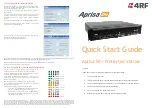
25
AM RF GAIN
on the left side of the re-
ceiver lets you tune a received signal
for the best SW reception. If the signal
is weak, turn
AM
RF GAIN
. If
the sound is distorted, turn
AM RF GAIN
toward –.
TUNING SSB STATIONS
SSB (single sideband) is very popular
among amateur radio and business ra-
dio users because of its superior signal
quality. Many amateurs who operate
SSB and transmit below 10 MHz gen-
erally use LSB (lower sideband), while
amateur and commercial stations who
transmit above 10 MHz generally use
USB (upper sideband). Your receiver
receives both USB and LSB transmis-
sions.
Follow these steps to receive SSB
stations.
1. Select an SW band (see “Select-
ing a Band” on Page 18).
2. If you know the frequency of an
SSB station, enter that frequency.
Or, scan the band for SSB stations
by slowly rotating
MANUAL TUN-
ING
, tuning through the selected
band until you hear an SSB sta-
tion. Or, scan the band for USB or
LSB stations by holding down
TUNING
or
TUNING
for
about 2 seconds until you hear an
USB or LSB station
Note: SSB stations sound dis-
torted when you tune to them in
the normal SW band. To help you
find SSB stations, watch for
deflections on the signal strength
indicator. Since SSB is transmit-
ted with a suppressed carrier, the
signal strength indicator will move
more quickly when there is a
transmission and more slowly dur-
ing pauses in the transmission.
3. When you have located an SSB
station, press
AM MODE
to receive
the transmission. Repeatedly
press
AM MODE
to switch between
USB or LSB transmissions (try
LSB for frequencies below 10
MHz or USB for frequencies
above 10 MHz).
4. Set
STEP
to
SLOW
then readjust
MANUAL TUNING
for maximum
intelligibility.
USING RDS
The receiver displays information
about FM radio stations that transmit a
Radio Data System (RDS) signal.
When the receiver receives an RDS
station, the station’s call letters appear
on the display. Also, if the station
broadcasts CT (clock time) informa-
tion, the receiver automatically cor-
rects the displayed time.
Summary of Contents for DX-398
Page 47: ...47 NOTES...
















































